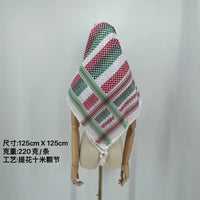The Ghutrah: A Fascinating Tale of Origins, Evolution, and Style
Ever wondered about the Ghutrah, that iconic Saudi men's headdress that seems to effortlessly combine tradition with a touch of modern flair? Well, you're not alone! There's a whole lot of curiosity surrounding this national treasure, from its practical uses in the desert heat to its stylish transformations over the years.
First things first, let's talk about the Ghutrah's humble beginnings. Believe it or not, the red and white-checkered version that's now a staple in Saudi fashion actually has roots in far-off London. It made its way to Saudi Arabia just a few decades ago, joining the ranks of the white Ghutrah that many Saudi men also wear with pride. And here's a fun fact: the Ghutrah is essentially a squared cloth cleverly folded into a triangle!
In the old days, even before Islam took root, wearing a headdress was just part of a man's daily routine in Arabia. It's said that the heat played a big role in this tradition. Early pictures of Arabia show men with cloths of various colors tied atop their heads. There were no fancy white or checkered Ghutrahs back then. In fact, it wasn't until about 50 years ago that the red and white Ghutrah became a common sight.
Now, let's chat about Eqal, the headband that keeps the Ghutrah in place. White was the go-to color, but styles varied. Black headbands weren't as popular in old photos. Back then, anything that could hold the Ghutrah was good enough. Even Lawrence of Arabia himself wore a folded cloth as a Ghutrah with a couple of thick headbands!
For quite a while, British soldiers in desert countries under the British Empire wore Ghutrah too. Its practicality caught on, and people in the Arab world started adopting the British style, giving it their own unique twists. It became popular in Iraq, Syria, Jordan, and later, Palestine. But as time went on, fewer people in these countries wore it, while it remained a national symbol in the Arabian Gulf countries.
Saudi Arabia embraced both the white and the red and white-checkered Ghutrah. Before that, a greenish Ghutrah was quite the rage among many, especially the old Saudi army and police. Interestingly, the white Ghutrah wasn't originally made in any Middle Eastern country. Some folks even referred to it as "Swissri," meaning from Switzerland, or "Stofel," which might have been the company that made it. This brand was a favorite until the 1970s.
As for the red and white-checkered Ghutrah, it wasn't an instant fashion hit among Saudi men. To this day, some folks still ponder the reason behind its popularity in Saudi Arabia. Meanwhile, in Palestine, the black and white checkered Ghutrah is the norm. Personally, I'm glad we went with the white and the red and white versions!
So, there you have it. The Saudi national headdress was designed in the United Kingdom and Switzerland. Even now, the shape and wearing style remain the same, but the fabric and material have become more stylish, with designs from well-known international brands like Dunhill and Gucci.
It's worth noting that even within Saudi Arabia and other Gulf countries, the Ghutrah is worn in different ways, often reflecting regional or cultural identities. For instance, experienced observers can often tell which part of the Kingdom someone is from just by the way they wear their Ghutrah. Similarly, long-time Gulf residents can differentiate between Saudis, Qataris, Bahrainis, Kuwaitis, Omanis, or Emiratis based on their headdress styles. While Saudis favor the red and white Ghutrah, men from other Gulf countries prefer the white one. Omanis and many from the UAE, on the other hand, wear it in a turban style with a variety of colors.
In the end, it's the British and the Swiss who gave us the modern-day Ghutrah design, a true testament to the fusion of cultures and traditions that makes the Ghutrah such a fascinating and beloved part of Saudi heritage.





